
Civil War
Local tradition has it that the Parliamentary army, under the command of Sir Thomas Fairfax, camped on Troopers Hill prior the siege of Bristol in 1645. It has also been suggested that the ditch between the hill and the allotments was dug at this time as a defensive earthworks.
It is known that the army approached Bristol via Keynsham and Hanham and it is possible therefore that Troopers Hill, with its views of the city, was used while the Parliamentary army was headquartered at Hanham, but we have found no firm evidence of it.

Copper, Brass & the Slave Trade
Copper + calamine (zinc ore) ==> Brass
Crews Hole became a completely different place in the eighteenth century when the copper smelting industry was established in the area. Copper ore was brought by boat, mainly from Cornwall and north Devon and coal was sourced locally. The copper produced was mostly used with calamine (zinc ore) from the Mendips in the manufacture of brass at Baptist Mills and other sites in Bristol.
Brass ==> West Africa ==> Slaves ==> Caribbean ==> Sugar ==> £££££
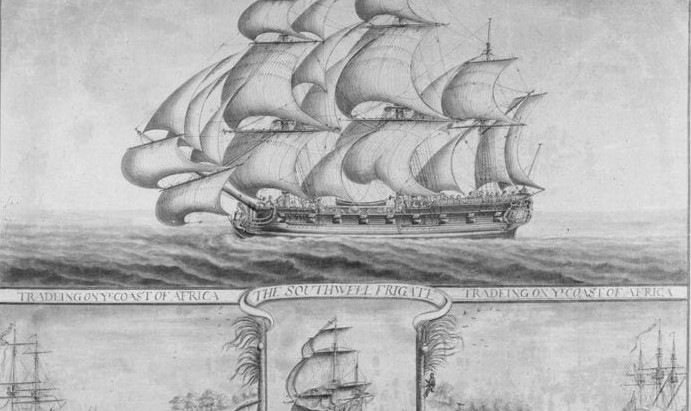 Many of the brass products (& some of copper) were exported to Africa to be exchanged for slaves as part of the 'triangular trade'. Indeed there is no doubt that the transatlantic slave trade was one of the main drivers for the development of the Bristol brass industry. Copper & brass manillas were the principal form of currency for the trade and are known to have been cast in Bristol. Other products including 'Guinea Kettles' and other forms of brass holloware that were traded for slaves were produced at the various brass mills in the area.
Many of the brass products (& some of copper) were exported to Africa to be exchanged for slaves as part of the 'triangular trade'. Indeed there is no doubt that the transatlantic slave trade was one of the main drivers for the development of the Bristol brass industry. Copper & brass manillas were the principal form of currency for the trade and are known to have been cast in Bristol. Other products including 'Guinea Kettles' and other forms of brass holloware that were traded for slaves were produced at the various brass mills in the area.
Abraham Elton (1654 – 1728), who was created a Baronet in 1717, established a copper smelting works at Conham in about 1698 and also purchased Troopers Hill in 1704. The Hill stayed in the Elton family until 1758. The family and particularly Sir Abraham Elton, 2nd Baronet (1679 – 1742) were active in the slave trade and invested in slave ships. The 1st & 2nd Baronets were both Mayor of and Member of Parliament for Bristol at various times and Masters of the Society of Merchant Venturers.
In around 1710 a copper smelting works was established by the Bristol Brass and Wire Company on land between the River Avon and where the Bull Inn now stands. This works became known as 'the Cupolas' and were the main industry in the vicinity of the hill.
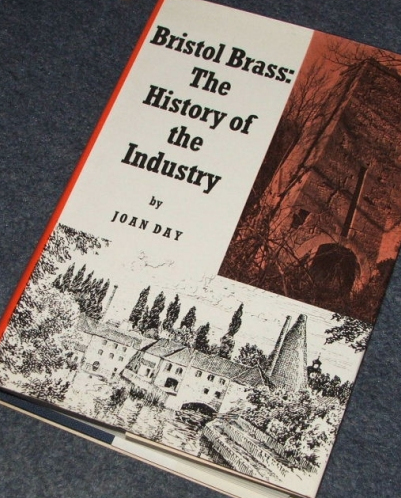 One of the partners and an active manager of the brass company from its start was Abraham Darby I. In 1708 Darby moved to Coalbrookdale - 'The Birthplace of the Industrial Revolution' - while it was at Coalbrookdale that Darby made his name, it was in Bristol that he developed the process for casting pots in greensand moulds and experimented with using coal as a fuel for smelting instead of charcoal, the key factors in his later success. It was also Bristol Quakers who had been involved in the copper and brass industries in Bristol who funded his works at Coalbrookdale. Thus Baptist Mills, Conham and Crews Hole are important, but often overlooked, sites in the history of the Industrial Revolution in Britain.
One of the partners and an active manager of the brass company from its start was Abraham Darby I. In 1708 Darby moved to Coalbrookdale - 'The Birthplace of the Industrial Revolution' - while it was at Coalbrookdale that Darby made his name, it was in Bristol that he developed the process for casting pots in greensand moulds and experimented with using coal as a fuel for smelting instead of charcoal, the key factors in his later success. It was also Bristol Quakers who had been involved in the copper and brass industries in Bristol who funded his works at Coalbrookdale. Thus Baptist Mills, Conham and Crews Hole are important, but often overlooked, sites in the history of the Industrial Revolution in Britain.
At some point the Brass Company started casting the waste copper slag into moulds to produce black building blocks. The best example of the use of these 'Bristol Black' blocks was in the building of the Black Castle at Arnos Vale but they can also be seen in many of the walls around the area. Historian Joan Day (see below) says that the production of the blocks may have followed complaints from the Bristol Authorities in 1749 about 'a great quantity of cinders laid upon the banks of the said river'. However, a cottage that used to stand on Conham Road that used these blocks in its construction had a date stone of 1729, so it appears that production of the blocks must have started before then. There is a group on flikr dedicated to collecting photographs of 'Bristol Black'.
The Swede R R Angerstein visited the area in 1754 as part of a tour of England & Wales to study industrial processes, he recorded what he saw so that he could report back to the Swedish Goverment. Angerstein reported that there were 49 copper-smelting furnaces in operation at Crews Hole.
The Brass Company purchased Troopers Hill from 'Sir Abraham Elton (3rd Baronet) and others' on 25th March 1758 for £150. From this point until the 1920s the land by the river that became the Tar Works and the Hill were in the same ownership. Sir Abraham Elton may have purchased the Hill for access to coal and stone for building. It is not clear why the Brass Company purchased the Hill; it may have been to allow the chimney & flue to be constructed (see below).
In around 1780 the Bristol Brass and Wire Company moved its copper smelting operations to Warmley having purchased the works of their rival William Champion and by about 1790 the company had abandoned the Crews Hole site.
The abandonment of the site by the Bristol Brass Company did not mark the end of copper smelting in Crews Hole. Joan day mentons that the site was leased to the Elton & Tyndall copper company until about 1796. In a thesis on the inductry in 2003, John Symonds says: "A short lived attempt at copper smelting was made by the firm of Issac Elton and Thomas Tyndall, and named Tyndall & Company, alias Elton & Company. Founded in the 1770s it was buying copper ore from Roe & Company of Macclesfield".
Matthews & Arnold are also reported to have had a brass and spelter (zinc) works in Crews Hole in the 1820s. So far we have no records of the use of the site between these dates but it could also have been used for lead smelting.
 More about the Copper Smelting & Brass industries in Bristol including their links to the African slave trade can be found on the Saltford Brass Mill web site:
More about the Copper Smelting & Brass industries in Bristol including their links to the African slave trade can be found on the Saltford Brass Mill web site:
Much of what is known about the Bristol brass industry was found by local expert, Joan Day who wrote 'Bristol Brass: The History of the Industry' in the 1970s and was the leading force in the restoration of the Saltford Mill. Joan gave a talk to Friends of Troopers Hill in July 2004. More recently, Tony Coverdale from the Brass Mill Project has also helped us in trying to establish the history of the Crews Hole site.

Troopers Hill Chimney & Flue
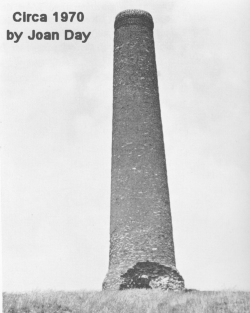 The chimney at the top of Troopers Hill was connected to a long flue or duct that ran up the side of the Hill from the smelting works near the river at the bottom. This connected to the chimney at the arch at the base of the chimney and the route of the flue is still visible as a dip in the ground.
The chimney at the top of Troopers Hill was connected to a long flue or duct that ran up the side of the Hill from the smelting works near the river at the bottom. This connected to the chimney at the arch at the base of the chimney and the route of the flue is still visible as a dip in the ground.
As can be seen in the 1970s photo part of the bottom of the chimney had been broken away where the old duct used to connect to it; the current arch must have been constructed in the 1970s or early 80s by the Council.
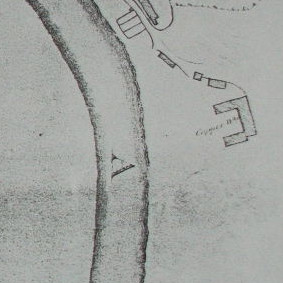 Part of Maule's 1803 map was shown to the Friends of Troopers Hill by the late John Cornwell, who ran the Bristol Coalmining Archives and was very enthusiastic about the industrial history of the area.
Part of Maule's 1803 map was shown to the Friends of Troopers Hill by the late John Cornwell, who ran the Bristol Coalmining Archives and was very enthusiastic about the industrial history of the area.
The map shows the 'Old Brass Works' where the cupolas were sited but also shows a separate 'Copper Works' adjacent to Troopers Hill. This works is located exactly where the flue from Troopers Hill chimney came down to the riverside.
There seems to be no reason to have built the works on this site, which was set back from the river, if it was not to benefit from using the hill. Since the hill and the riverside site were both owned by the Brass Company it seems very likely that the chimney served this new Copper Works in the 1780s or 90s, perhaps a little earlier. It is likely that these works were the works of the Elton & Tyndall copper company described above.
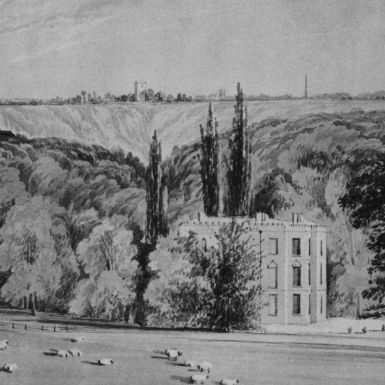 It is certain that the chimney was built before 1826, since it is shown in a drawing from this date of the view from Arnos Court commissioned by GW Braikenridge.
It is certain that the chimney was built before 1826, since it is shown in a drawing from this date of the view from Arnos Court commissioned by GW Braikenridge.
The use of a long flue to connect a furnace to more distant chimney is more commonly used in lead smelting, rather than in copper smelting. These flues are discussed by Dr. D.G.Tucker in the Bulletin of the Historical Metallurgy Group in 1972 published on the Outside Echo website. These long flues had initially been built to 'prevent adjoining pastures being injured by the smoke' but it was found that lengths of horizontal flue collected significant quantities of lead and some silver that adhered to the inside of the flue. As a result flues were constructed at leadworks with long horizontal sections, often using chambers with partitions to create the same effect, an example was at the Blackswarth Leadworks. The flues were entered through access hatches periodically to scrape the deposits off the inside. Grassington Moor chimney & flue, described at the bottom of the page here - gives a good impression of how we think the Troopers Hill Chimney flue may have looked.
Dr Tucker mentions the Troopers Hill chimney (at grid ref ST 628 732) as an example of long flues being occassionally used in Copper Smelting. He believes this was 'only to lead toxic material away from areas of habitation'. It could have been to recover arsenic, as arsenious oxide or sulphur from the fumes but this appears only to have been used in the early stages of ore preparation at the mine site. The 1886 plan clearly shows chambers at the bottom of the hill, these would not have been necessary if the flues was purely to remove the fumes from the works area, Dr Tucker may not have been aware of these chambers. It is possible, therefore, that the chimney was initially constructed for a leadworks rather than copper smelting and indeed Donn's map of 1769 (used on the cover of a book by William Sanigar in the 1950s) does show a leadworks in the area. The works may then have been converted for copper smelting, this theory would mean that the chimney & flue could date from as early as the 1760s and then this may have been the reason that the Brass Company purchased the Hill in 1758 (see above). Links to Information on Copper Smelting >>.
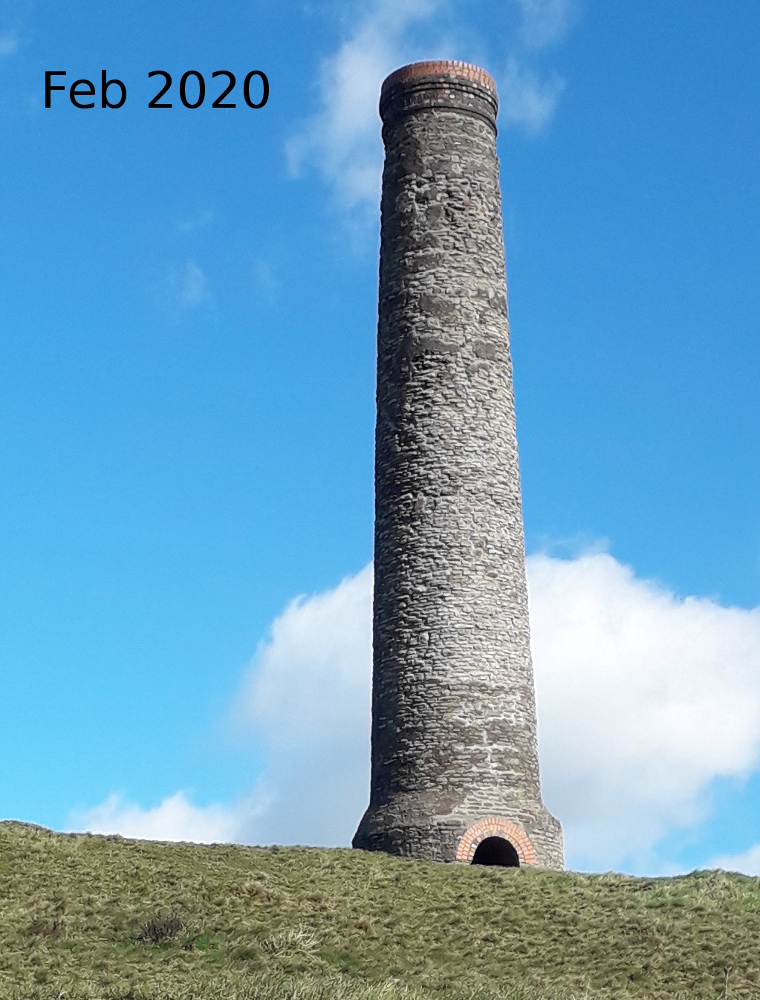 By the end of the 1800s the chimney was being used by Stone & Tinson who had a large chemical works on the site shown as a copper smelter on the 1803 map. Stone & Tinson are shown as the occupiers of this area on the plan relating to fire clay mining in 1886. There was also a separate lease dated 1889 where the land is leased to Thomas Stone and in a document dated 1904 it was said to be in the occupation of 'Thomas Stone Chemical Manufacturer'. It seems that this company continued to use the chimney until about the time of the First World War. As described below Butlers took over the Stone & Tinson site in 1923 or 24 after it had closed but by then the chimney was disused so it was never used by Butlers.
By the end of the 1800s the chimney was being used by Stone & Tinson who had a large chemical works on the site shown as a copper smelter on the 1803 map. Stone & Tinson are shown as the occupiers of this area on the plan relating to fire clay mining in 1886. There was also a separate lease dated 1889 where the land is leased to Thomas Stone and in a document dated 1904 it was said to be in the occupation of 'Thomas Stone Chemical Manufacturer'. It seems that this company continued to use the chimney until about the time of the First World War. As described below Butlers took over the Stone & Tinson site in 1923 or 24 after it had closed but by then the chimney was disused so it was never used by Butlers.
In his Memories of Troopers Hill, Crews Hole, Conham & Hanham Tom Fry describes his childhood in the area aound 1910 - "The old stack still standing on the hill top, at that time belched
out smoke which was carried up the side of the hill from Crews
Hole Chemical Companies works, by means of a long flue
formed by large half round steel plates. The flue was a source
of amusement to us, for we sat on the steel plates – which were
hot during cold winters days, or else slid down them. Once they
had to haul out Mr Macey’s donkey when it had slipped in the
broken flue - a very precarious job because it was covered in hot
soot."
The chimney is currently 15.92m or 52ft 3in tall (measured in 2016). We believe that originally it would have been taller, with a brick section at the top extending it by about half of the current height, so that the chimney would have been two-thirds stone and one-third brick.
The chimney at the bottom of the Hill on the corner of Troopers Hill Road and Crew's Hole Road was constructed for Coal Mining.
Bristol City Council remain responsible for maintaining both chimneys and did done some work on them over the period 2013 to 2016; for more details click here.

The Somers Family and Industry by the River Avon
Troopers Hill and the land next to the river was put up for auction by the brass company in 1813 but it was not finally sold until 1828 when Dr Benjamin Somers became the owner.
Dr Benjamin Somers was born in 1784, he qualified MD at St Andrews and in 1811 married Mary Pope, heiress to the Childewicke Estate, who he had met while practicing in Hertfordshire. The couple moved to Wrington shortly after they married. In around 1820 Dr Sommers gave up medicine and became involved in lead smelting in the Mendips (near where he lived). In 1827, the year before he bought the Hill and adjacent land, he had registered a patent 'for improvements on furnaces for smelting different kinds of metals, ores &c.'.
According to 'Industrial Archaeology of The Bristol Region' written by Angus Buchanan & Neil Cossons in 1969, 'Dr Benjamin Somers had a brick smelting-house erected for re-working old slag and slimes' at Charterhouse in the Mendips in 1824. It seems likely therefore that his purchase of the Troopers Hill site was linked to his smelting activities and possibly to the presence of old slag - something that James Mitchell also tried to exploit a few years later, see below. In the 1840s Tithe apportionments, as well as being the owner of Troopers Hill, Benjamin Somers is listed as the occupier of part of the leadworks in Blackswarth . He was also involved briefly with The Tamar Smelting Works in Devon.
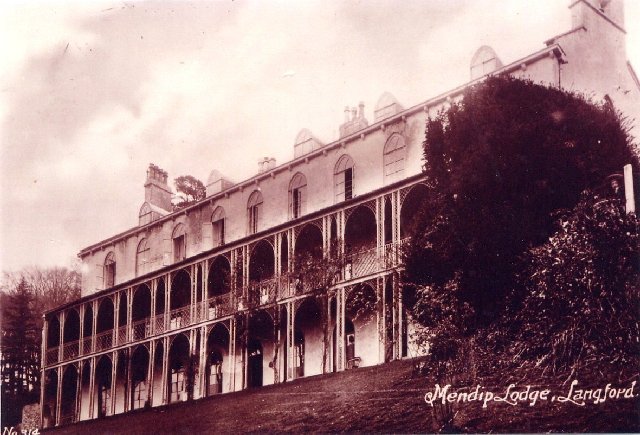 By the 1840s Dr Benjamin Somers was obviously very wealthy. In 1841 he bought Langford Place and then in 1846 additionally bought Mendip Lodge which was a very large house and included what is now Dolebury Warren Nature Reserve in its extensive estate.
By the 1840s Dr Benjamin Somers was obviously very wealthy. In 1841 he bought Langford Place and then in 1846 additionally bought Mendip Lodge which was a very large house and included what is now Dolebury Warren Nature Reserve in its extensive estate.
Mendip Lodge had been built by Rev Thomas Sedgwick Whalley (1746-1828) who was a relative of the Somers family and had inherited Langford Court through his wife. Dr Somers' father had died when he was only eight years old and his mother had then moved to Springhead Farm near Mendip Lodge, so the the property was well known to him. Indeed (as described by Prof Chris Stephens in his book about Rev Whalley) he had initially purchased the property in 1819, but had had to sell it back to Rev Whalley as he could not keep up payments on the loan.
Dr Benjamin Somers died in 1848 leaving the house to his wife, Mary, for the use of their son, Thomas.
Thomas Somers had married Elizabeth Williams in 1840 and their son, Benjamin Edward, was born at Mendip Lodge in 1852. Thomas died only 10 years after the birth of his son and hence it is Elizabeth Somers of Mendip Lodge whose name appears on many of the leases related to Troopers Hill and the various works adjacent to the river. It was also Elizabeth (sometimes refered to as Lady Elizabeth Somers) who gave permission for the Smallpox Hospital to be built in 1888.
Thomas & Elizabeth also had two daughters, Mary Blanche and Rose Elizabeth. In October 1868 Mary Blanche Somers, married Colonel Evan Henry Llewellyn at Burrington parish church. The celebrations in the village were described in the Bristol Mercury, with Mary Blanche being referred to as "the fair flower of Mendip, the joy and the pride". Mary Blanche and Evan Henry Llewellyn purchased Langford Court shortly after their wedding; they are great, great grandparents of David Cameron, Baron Cameron of Chipping Norton, former Prime Minister of the United Kingdom.
From 1843, and possibly earlier, the site by the river, as well as mining and quarry rights on the Hill, were leased by the Somers family to various companies.
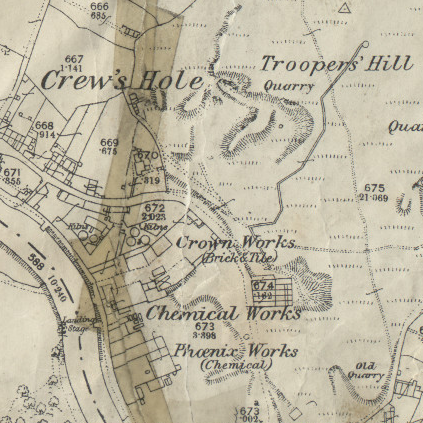 These companies included Stone & Tinson (later Conham Chemical Works) who, as mentioned above, used the chimney. Later they became 'deputy landlords' of the Hill after mining for fire clay ceased. Their works were between the Pheonix Chemical Works and the Crown Clay Company (fire clay).
These companies included Stone & Tinson (later Conham Chemical Works) who, as mentioned above, used the chimney. Later they became 'deputy landlords' of the Hill after mining for fire clay ceased. Their works were between the Pheonix Chemical Works and the Crown Clay Company (fire clay).
The east of the site owned by Somers was leased to Roberts & Daines for the Tar Works. Butlers purchased the area they were then leasing in 1901 before expanding to and purchasing the rest of the site by 1924 when the Somers family also sold Troopers Hill itself to J. J. Ballard.
South-East of the tar works was the site of a school, if this area (which included part of the site of the original brass works) was owned by the Somers family, it was sold prior to the Tithe map being produced in the 1840s. It was purchased by Butlers some time after the school closed and Air Balloon School was built to replace it.
There was a report to the St George’s Local Board in October 1879 from Mr Henry Grace, the medical officer of health for the district. This gave a description of the various works then operating along the Avon starting at Netham (which was then part of St George) and moving east to include the tar works. The locations of many of these can by seen on the Council's Know Your Place maps.
In 1924 it was Benjamin Edward Somers, son of Thomas & Elizabeth Somers and grandson of Dr Benjamin Somers (the original purchaser 96 years before) who sold Troopers Hill.

Heaps of Dross
A fuller quote from Elizabeth Emra writing in the 1830s describes "the barren and quarried hill, with its yellow spots of gorse and broom, and its purple shade of heath, raising itself above the dark heaps of dross". The dictionary definition of dross is 'The scum thrown off from metals in smelting' and refers to the the slag that was left from the copper and lead smelting in the valley.
These 'heaps of dross' may have been what attracted Dr Benjamin Somers to Crews Hole; there was another short lived enterprise based on these heaps of dross after his death, perhaps continuing his work. Nigel emailed us from Cheshire to say that he had found a reference to James Michell, responsible for copper mining at Alderley Edge in Cheshire in the 1860s, being declared bankrupt in 1856. His address then was given as Crews Hole, St George and Westbury-upon-Trym and he is described as a lead smelter.
Nigel also found a
newspaper article in the Bristol Gazette for 6 November 1856 which explains Michell's role in Bristol. Nigel writes, "Michell went to Crews Hole in 1853 to reprocess the slag left
by the earlier working, said to be 130 years old. He probably brought with
him knowledge from his lead smelting experiences in Spain and Derbyshire and
possibly had made contact with the chemist William Henderson at this time.
Henderson developed the processing of copper ores with acid to extract the
metal without having to roast it at high temperatures and, possibly, this is
what Michell was going to do. Either way, it didn't work because the 'good'
slag was buried under more recent material and after 3 years (June 1853 to
August 1856) Michell declared himself bankrupt."
It seems that after the failure of his business venture in Crews Hole James Michell continued to be involved mining in Cheshire while still living in Bristol. Sadly this led to his death in 1862. The Bristol Gazette of 4 December that year reported 'a shocking accident occurred on Thursday morning last to Mr Michell, of the Hermitage, Westbury on Trym, which, we regret to add terminated fatally'. It reports that his foot slipped as he turned round to talk to his agent while ascending the pit and he fell over 30 feet to the bottom.

Coal Mining & Lower Chimney
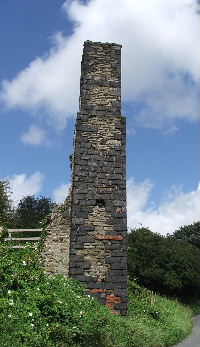 So, while some lead smelting continued at Blackswarth, copper smelting in Crews Hole during the early years of the nineteenth century seems to have been on a much smaller scale than in the eighteenth century. On Troopers Hill itself there was some quarrying of pennant sandstone during this period, but the most significant development was the opening of Troopers Hill Pit.
So, while some lead smelting continued at Blackswarth, copper smelting in Crews Hole during the early years of the nineteenth century seems to have been on a much smaller scale than in the eighteenth century. On Troopers Hill itself there was some quarrying of pennant sandstone during this period, but the most significant development was the opening of Troopers Hill Pit.
The chimney or stack that still stands at the junction of Troopers Hill Road and Crews Hole Road is all that remains of this colliery. Originally the chimney was at the corner of the engine house and parts of the walls of that building can still be seen.
The corners of the stack are formed with black copper slag blocks. This structure is also Grade II listed. A Desk Study into the history of this chimney was carried out by Bristol & Region Archaeological Services for Bristol Parks in 2008, it contains images of several old maps.
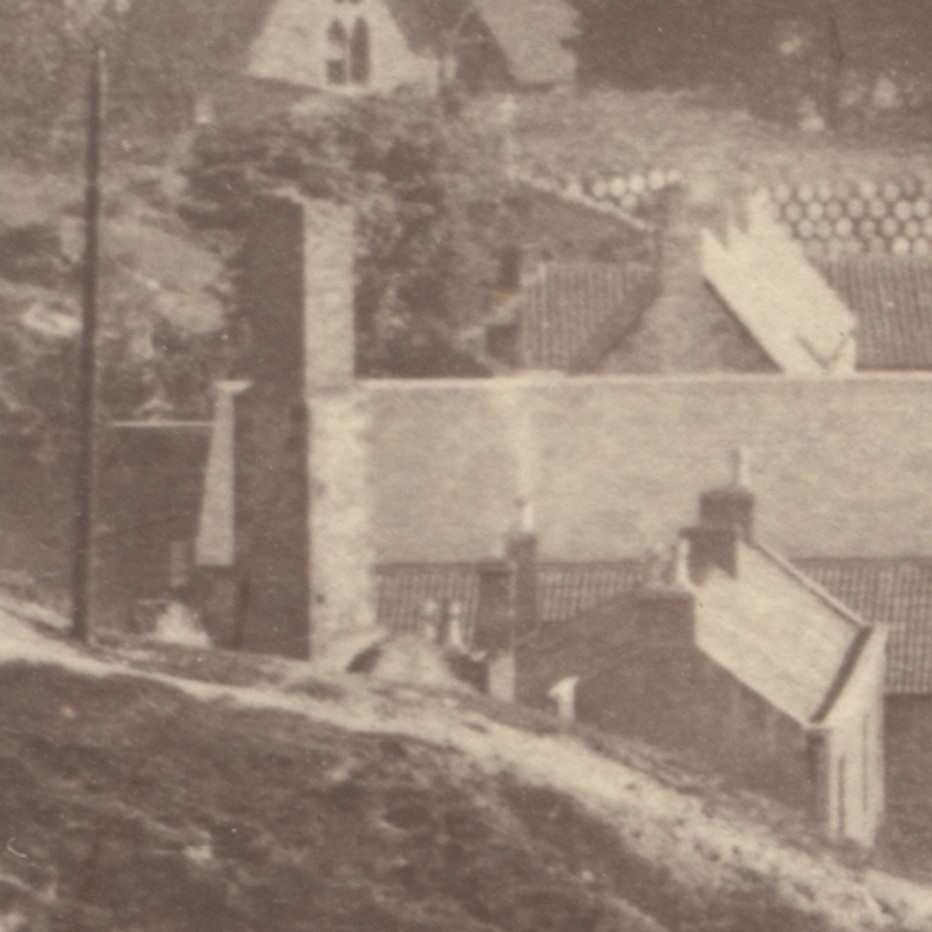 In 2013 some works was carried to prevent the stone work from deterioating; at the same time brickwork was reinstated to replicate the start of a brick section that originally existed at the top.
In 2013 some works was carried to prevent the stone work from deterioating; at the same time brickwork was reinstated to replicate the start of a brick section that originally existed at the top.
This missing third section can be seen in a view of the Tar Works included in an album from the 1890s (part shown here). In the photo, the lowest section of the chimney is hidden by the Hill, only the part of the chimney above the adjacent chimney pots can be seen. The top section is clearly built differently, with no black slag quoins. The very top already appears to be damaged.
More details of the 2013 works >>
Butlers' Photographs from the 1890s >>
The mine shaft was behind the engine house on Troopers Hill in an area now covered in bramble; it is assumed that it was filled in after the colliery closed. The colliery, which was also known as Crews Hole Pit, was mining coal from the early 1800s and although the exact closure date is not known it was before 1845.
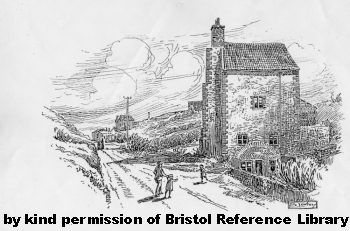 A second mine shaft and engine house was situated further up Troopers Hill Road and is shown in this drawing by Samuel Loxton from about 1914 (click on the drawing for a larger version). Both engine houses would have looked similar and the two shafts would have been linked below ground with one acting as the updraft ad one as the downdraft to ensure the mine was kept ventilated.
A second mine shaft and engine house was situated further up Troopers Hill Road and is shown in this drawing by Samuel Loxton from about 1914 (click on the drawing for a larger version). Both engine houses would have looked similar and the two shafts would have been linked below ground with one acting as the updraft ad one as the downdraft to ensure the mine was kept ventilated.
In his book 'The Bristol Coalfield' John Cornwell refers to the Loxton drawing and says: 'A notable feature of the engine house is a large archway set in the side of the structure for installing and changing the cylinder of the engine, which is a feature of the early 19th century'.
Our thanks to Bristol Reference Library for their permission to reproduce the Loxton drawing.
There was also coalmining on Troopers Hill prior to the 1800s. Several coal seams outcrop in the area and it is likely that this would have been mined on a small scale from the 1600s or maybe earlier. On Troopers Hill there is evidence in the shape of the land of mine shafts that are likely to date from the 1700s. In 2010 one of these showed signs of collapse as described here.

Troopers Hill - Origin of the Name
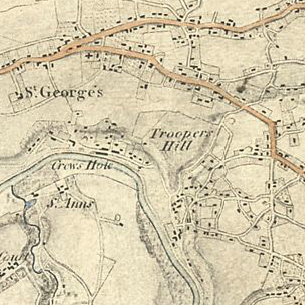 1826 marks the first recorded use of the name 'Troopers Hill' when it was shown on a preliminary drawing of the Bristol area made by the surveyors for the Ordnance Survey. This was one of a series of drawings which were copied to produce the first OS maps. Prior to this date the hill had been referred to as 'Harris Hill' or 'Truebody's Hill' (which was used on another OS drawing of the Bath area dated 1815).
1826 marks the first recorded use of the name 'Troopers Hill' when it was shown on a preliminary drawing of the Bristol area made by the surveyors for the Ordnance Survey. This was one of a series of drawings which were copied to produce the first OS maps. Prior to this date the hill had been referred to as 'Harris Hill' or 'Truebody's Hill' (which was used on another OS drawing of the Bath area dated 1815).
In 1937, local historian William Sanigar wrote to the Ordnance Survey to ask about the name. In his letter he states that the Truebody family were owners and tenants of land in and around the neighbourhood for about a hundred years.
Troopers Hill and Truebody's Hill were both used through much of the nineteenth century, with Troopers Hill becoming the accepted name by the end of the century, possibly because of its use on the Ordnance Survey map. It remains in doubt as to whether the name came from the use of the hill by troopers in the civil war or at some other time; or whether it was simply a corruption of Truebody's Hill.

Fireclay Mine and Works
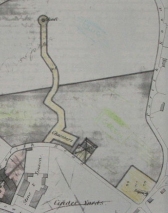 The plan shown here formed part of an 1886 lease of the land to the west of Stone and Tinson, together with mining rights under the hill, to the Bristol Fireclay Company. The lease is difficult to read but the wording was kindly typed for us by Margaret Watson from a copy given to us by the Council's property office, who have also given us permission to reproduce it. You can download a copy of the typed document here. In the lease the land is stated to have been formerly occupied by Mrs Elizabeth Braine and Ann Randall followed by Messrs Johnston Andrews & Company and then the Crown Clay Company. The plan shows the duct to the chimney, the cottages and the engine house as areas that shouldn't be undermined. The fireclay mines extended right under the hill and continued in use until they were abandoned in 1908. Two seams of clay were mined the five feet thick Dibb Clay and the deeper six feet thick Buff Clay. Two mine entrances were within the works area, while a third was in a quarry on the south-west side of the hill. Fireclay is often found below coal seems and it is possible that some of the works were opening up old coal mines.
The plan shown here formed part of an 1886 lease of the land to the west of Stone and Tinson, together with mining rights under the hill, to the Bristol Fireclay Company. The lease is difficult to read but the wording was kindly typed for us by Margaret Watson from a copy given to us by the Council's property office, who have also given us permission to reproduce it. You can download a copy of the typed document here. In the lease the land is stated to have been formerly occupied by Mrs Elizabeth Braine and Ann Randall followed by Messrs Johnston Andrews & Company and then the Crown Clay Company. The plan shows the duct to the chimney, the cottages and the engine house as areas that shouldn't be undermined. The fireclay mines extended right under the hill and continued in use until they were abandoned in 1908. Two seams of clay were mined the five feet thick Dibb Clay and the deeper six feet thick Buff Clay. Two mine entrances were within the works area, while a third was in a quarry on the south-west side of the hill. Fireclay is often found below coal seems and it is possible that some of the works were opening up old coal mines.
In a report in to a accident on Troopers Hill in 1913 when 10 year old William Burfitt sadly lost his life digging for coal during a miners strike (see page 5 of Memories of Troopers Hill, Crews Hole, Conham & Hanham by Tom Fry) George Hendy, a foreman for Stone & Tinson, is quoted as saying that the firm were 'the deputy landlords' of the land. The ground was private property, and was formerly rented by the Fire Clay Company'. He said that 'those who went on the land trespassed, and he had warned men who went to dig on the ground of their offence'. He added that 'men lately had broken into the old Fire Clay Company's mines and worked down under the seam of coal, about 60 feet, with the idea of driving into another seam on the east side of the hill. The chemical firm did not complain of the people having the coal, but because of the dangers attached to such a practice'.

Pennant Sandstone Quarrying
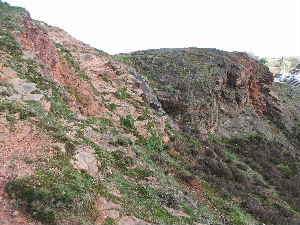 The industry that had the most effect on the shape of Troopers Hill as we see it today was the quarrying of pennant sandstone for use in building.
The industry that had the most effect on the shape of Troopers Hill as we see it today was the quarrying of pennant sandstone for use in building.
The 1890 Ordnance Survey map shows a quarry in what is now known as 'the gully'. Comparison of this map with the second edition Ordnance Survey map of 1904 clearly shows that a lot of rock was removed between the dates of the surveys for these two editions. The shape of the hill in 1904 was much as it is now so quarrying must have ceased soon afterwards. The humps between the gully and Troopers Hill Road are tipped waste from this quarry.
A quarry is also shown on the south-west of the hill on the 1890 map that has become an 'old quarry' by 1904. The 1890 map also shows an 'old quarry' adjacent to the colliery engine house at the Crews Hole end of Troopers Hill Road.
Some of stone from Troopers Hill was used in the construction of nearby Wesley Memorial Church which was completed in 1907. An account by WJ Clarke, published in 1911, says,
"Two quarries were also placed at our disposal free of rent charge. One of these was at Bryant's Hill [...] The other was at Troopers' Hill, the property of B. Somers, Esq., of Mendip Lodge. This was at first let to us at a rental of £12 per annum, but this agreement was afterwards cancelled, and free use of the quarry was granted for two or three years, during which most of the rubble stone required was obtained and hauled to site."

Butler's Tar Works
Coal ==> Coke + Tar + Ammonical Liquor + Gas
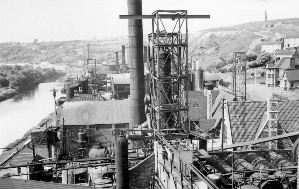 1843 saw the start of a new industry adjacent to Troopers Hill that dominated the area until 1981. In the mid-1800s coal tar was increasingly being produced as a waste product by the gas works.
1843 saw the start of a new industry adjacent to Troopers Hill that dominated the area until 1981. In the mid-1800s coal tar was increasingly being produced as a waste product by the gas works.
The Great Western Railway from Bristol to Paddington was built under the direction of I K Brunel between 1835 and 1841, with the Bristol & Exeter Railway and other lines soon following.
In 1838 Bristol born John Bethell patented a process for using creosote from coal tar as a timber preservative and Brunel realised that its use would be a benefit to his new railways; coal tar was also available in Bristol from the gas works near Temple Meads station.
It appears that Brunel took out a licence with John Bethell for use of his patent and also received technical advice from him. We know that timber for the Bristol & Exeter Railway was being treated with creosote near Temple Meads in 1841 as it was the cause of a major fire adjacent to the railway terminus. Soon afterwards timber was being treated on the site of the 1700s copperworks at Crews Hole. The creosote was distilled from coal-tar, which was a by-product of the manufacture of town gas and Crews Hole became the site of the tar distillery that took coal-tar from gas works in Bristol and further afield, including Bath.
Prior to 1863, the Crews Hole works were owned and financed by Roberts & Daines who also owned an Iron Works and timber yard in Silverthorne Lane where timber was also treated with creosote, this works was later also used by Butlers. Evidence from newspaper reports has shown that George Hennet (a contractor working for Brunel) was also involved in the very early days at Crews Hole, he was also mentioned in the reports of the 1841 fire at Temple Meads.
In 1863 a fire broke out that nearly destroyed the Crews Hole Works and Robert & Daines then sold the works to William Butler.

William Butler 1818-1900
 William Butler was born on 28th February 1819 in Leicestershire, he married Ann Boam in 1839 at Spondon in Derbyshire. It is likely that William came to Bristol in 1840 to work on railway construction in the area, including on the Bristol and Exeter Railway, almost certainly for George Hennet. In 1841 he was living in Bedminster and his occupation was given on his second child's birth certificate as 'plate-layer'.
William Butler was born on 28th February 1819 in Leicestershire, he married Ann Boam in 1839 at Spondon in Derbyshire. It is likely that William came to Bristol in 1840 to work on railway construction in the area, including on the Bristol and Exeter Railway, almost certainly for George Hennet. In 1841 he was living in Bedminster and his occupation was given on his second child's birth certificate as 'plate-layer'.
Butler came to St George in February 1843 at the age of 24 years. He was appointed as manager of the tar works from the start of operations, or at least from very early on. It is likely that George Hennet (or possibly Brunel) was responsible for his appointment. William Butler then moved to live in Gloucestershire in 1860 where he set up his own Tar Distillery near Gloucester.
However, William Butler returned to live in St George when he purchased the Crews Hole Works after the 1863 fire. He then operated the plant under the name of William Butler & Co Ltd along with the Gloucester works.
William and Ann's youngest child (of 11), Ada, was born in November 1863 in St George. Two sons had died as infants but five daughters and four sons grew to adulthood and all married, to
create a large extended family. The family lived in Summerhill House opposite the 'milesone path' entrance to Troopers Hill Field from around 1866. On 4th March 1875 William Butler purchased Clifton Grove in Clifton and he and Ann moved there. Their odest son, William Henry Butler, continued to live at Summerhill House until 1915.
William Butler retired from the Tar Distilling business in 1889. By that time he had also become involved in a lot of other activities in the local area. He was chairman of the St George Local Board (from its formation in 1874 until 1889) and also chairman of the Bristol Tramway Company until his death in 1900. For most of his life he was very much involved in the United Methodist Free Church; giving them substantial gifts for building new chapels.
William Butler’s wife Ann died in 1886 and was buried in Avon View Cemetery, in the grave overlooking the Tar Works where William would join her when he died in October 1900. It is reported that all the trams in Bristol came to a halt for one minute as a mark of respect to their chairman when he was laid in his grave.
But there is one other part of William's life story that only came to light in 2025; he married again only just over a year after Ann died. His second wife was Elizabeth Shellard who was 21 years younger than William and the sister of one of his son-in-laws, Edwin Shellard.

Tar Works in the 1890s
In the 1800s the Tar Works only occupied a relatively small section of the site by the river, extending from opposite Troopers Hill Road, to opposite Nibletts Hill. As described above, the area to the west was leased to various chemical companies. To the east was a school.
The two photographs below show the works as it was in the 1890s.
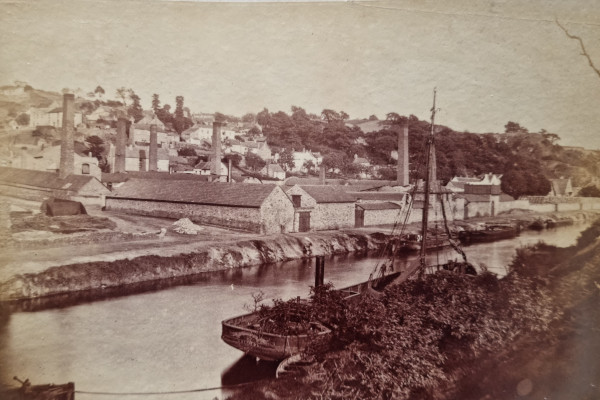
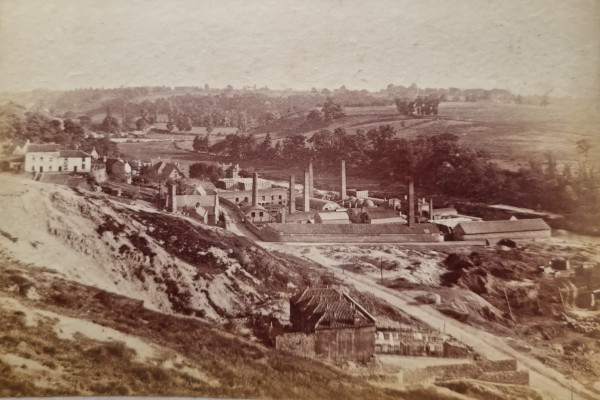
These photographs are taken from pages of a photo album believed to have belonged to the Butler family and initially shared with us by Nigel Addison. The album has been cut up, but fortunately most of it has been kept together and we now have the originals.
More details together with higher resolution copies of these and other photos from the album can be seen via the link below.
William Butler died in October 1900 having retired from the business and handed it to his sons in 1889; his grave stands in Avonview Cemetery overlooking the works. Nearby is the grave of one of Butlers' employees, George Lacey, who tragically died in a fire at the Crews Hole works in 1897.

Tar Works in the 1900s
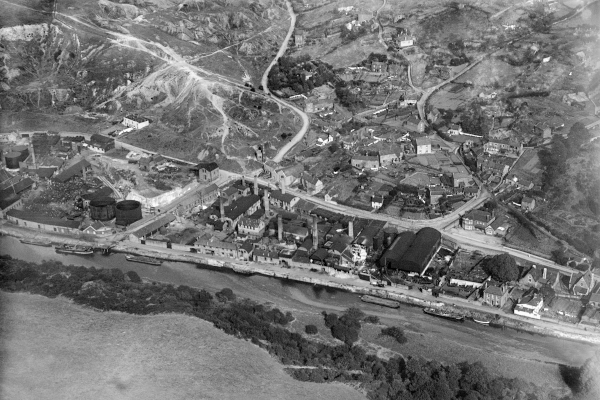 Through the early 1900s, William Butler & Co Ltd became a very successful and innovative company and expanded their operations at Crews Hole.
Through the early 1900s, William Butler & Co Ltd became a very successful and innovative company and expanded their operations at Crews Hole.
When the adjacent Conham Chemical Works closed in 1904 and Stone and Tinson's in 1924, both sites were incorporated into the Butler Works together with the site occupied by the fireclay mine. As the Works also incorporated the school buildings and the land around them; Butlers eventually occupied the whole area between Crew's Hole Road and the river adjacent Troopers Hill.
This aerial photograph showing the Tar Works and the lower part of Troopers Hill, was taken in 1926 and is from the Britain from Above collection. You can click on the image to see a high resolution version The image 'EPW016976 William Butler and Co (Bristol) Ltd Tar and Rosin Works, Crew's Hole, 1926' is © Historic England and used under licence.
In 1952 Butlers separated their tar distillation and other businesses with the formation of Bristol and West Tar Distillers, in which the Southwestern Gas Board took a 25% stake.
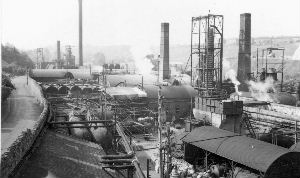 In 1962 the Gas Board became sole owners of Bristol and West Tar Distillers, and soon afterwards Butlers moved all their other operations away from Crews Hole and Silverthorne Lane to a new base at the Rockingham Works at Avonmouth where they operated under the name of Butlers Chemicals Ltd. Butler's had had a fuel distribution depot at Royal Edward Dock in Avonmouth since the 1920s and this part of the business also continued. Below Troopers Hill the Gas Board continued to operate the tar works to treat the crude tar generated from the production of town gas, the tar still came to Crews Hole from Bristol and the wider area, including Bath, Weston-super-Mare, Bridgewater, Cheltenham & Glouscester as well as South Wales.
In 1962 the Gas Board became sole owners of Bristol and West Tar Distillers, and soon afterwards Butlers moved all their other operations away from Crews Hole and Silverthorne Lane to a new base at the Rockingham Works at Avonmouth where they operated under the name of Butlers Chemicals Ltd. Butler's had had a fuel distribution depot at Royal Edward Dock in Avonmouth since the 1920s and this part of the business also continued. Below Troopers Hill the Gas Board continued to operate the tar works to treat the crude tar generated from the production of town gas, the tar still came to Crews Hole from Bristol and the wider area, including Bath, Weston-super-Mare, Bridgewater, Cheltenham & Glouscester as well as South Wales.
Until 1967 the tar mainly came by train to Silverthorne Lane, it was then carried to Crews Hole by four barges - Carbolate, Isobelle, Jolly and Darby. With the opening of the Servern Bridge it was cheaper to bring tar from South Wales by road tanker directly to Crews Hole and this made the barge operation uneconomic; so all tar transport was switched to road and the barges sold, ending over a hundred years of barge traffic to Crews Hole.
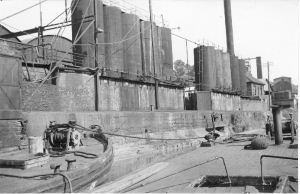 The introduction of North Sea Gas stopped the production of tar at the various gas works, but tar was still being produced by the coke works linked to the steel industry in South Wales and so a means of getting rid of this waste product was still required.
On 1st April 1970 the ownership of Bristol and West Tar Distillers changed hands for the last time when it became owned by the British Steel Corporation (BSC). The contraction of the steel industry in the late 1970s reduced the need for tar distillation and so the Crews Hole works closed in 1981 as BSC reduced the number of tar plants that they operated.
The introduction of North Sea Gas stopped the production of tar at the various gas works, but tar was still being produced by the coke works linked to the steel industry in South Wales and so a means of getting rid of this waste product was still required.
On 1st April 1970 the ownership of Bristol and West Tar Distillers changed hands for the last time when it became owned by the British Steel Corporation (BSC). The contraction of the steel industry in the late 1970s reduced the need for tar distillation and so the Crews Hole works closed in 1981 as BSC reduced the number of tar plants that they operated.
The aftermath of an incident involving a tanker collecting tar from the Works when it was owned by British Steel can be seen here.
The Butler company continued to operate at Avonmouth, it was taken over by Tenneco Chemicals in 1967 and since then ownership has changed many times with further takeovers and sales in the international chemical industry. 'Butler Fuels' continues to exist, now (2025) as part of 'Certas Energy'.

The Tar Works in Published Works
 The History of Wm. Butler & Co. (Bristol) Ltd.
The History of Wm. Butler & Co. (Bristol) Ltd.
In 1954 a book was published by the company giving details of its history over the previous 110 years. Friends of Troopers Hill were given a copy of this book, which was written by Dr T. Howard Butler, the founder's grandson, at their history exhibition in September 2005.
Seventy years on, this book is now out of copyright and has been digitised by the Bristol Record Society.
You read about the book and download a copy via the link below.
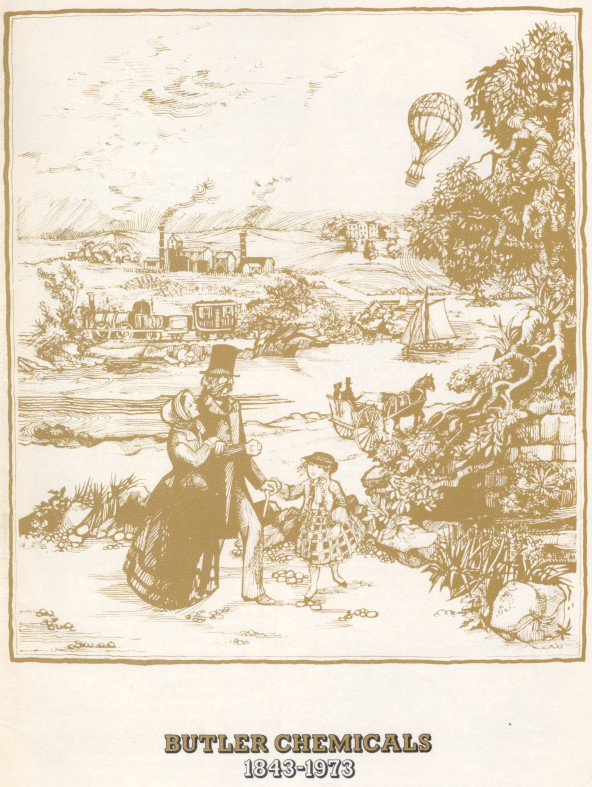 Butler Chemicals 1843-1973
Butler Chemicals 1843-1973
By 1973 the tar works at Crews Hole was in the ownership of British Steel, the remaining part of the Butler company, based at Avonmouth, was owned by Tenneco Chemicals but still operating under the name 'Butler Chemicals'. They produced a small illustrated pamphlet - Butler Chemicals 1843-1973 (pdf).
Papers by Raymond Holland
Another excellent account of the history of the works is a 2002 paper written by Raymond Holland, who worked at the tar works for 20 years. Raymond gave a talk based on his paper to the St George History Group in September 2009. It has been published by the Society of Chemical Industry under the title 'A History of Tar Distillation at Crew's Hole, Bristol' and can be downloaded here (ref 123/2002). Raymond also wrote about the works for the Bristol Industrial Society Journal No 13, published in 1980 - when the Works were still open.
ALHA Books - The Butlers & the Coal-Tar Distillery at Crew’s Hole
You can also read more about the Tar Works and the Butler family in ‘The Butlers & the Coal-Tar Distillery at Crew’s Hole’ by Brian Vincent and Raymond Holland (ALHA Books).
Sadly Raymond Holland died in 2018; the photographs of the works on this page taken in 1953 belonged to Raymond Holland who was kind enough to give us permission to use them when we met him in 2008. More of Raymond's 1953 photographs and some from the 1980s can be seen in our Old Photographs sets, together with many other photos showing the Tar Works and Troopers Hill and the changes that have taken place since the works closed

Troopers Hill Smallpox Hospital
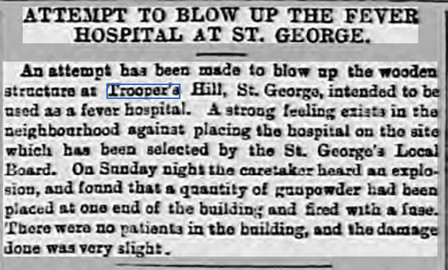 A major controversy raged in St George in 1888 over the construction of a Smallpox Hospital on Troopers Hill.
A major controversy raged in St George in 1888 over the construction of a Smallpox Hospital on Troopers Hill.
The 12 bed wooden structure built in March 1888 was located on the relatively flat area of the Hill next to what is now Greendown.
There was a strong local campaign to get the hospital removed with many letters to the local papers, meetings of local ratepayers on the Hill and a petition. More direct action was taken at the end of April 1888, when there was an explosion apparently caused by gunpowder placed next to the hospital and ignited.
The hospital was only on the site for a short time as it was reported in July 1889 that ‘in deference to the agitation against it’ the owner of the land had called upon the Local Board to take it down. A celebration to mark its removal took place in September 1889.
Read more details and newspaper extracts here.

Playground & Gathering Space
Prior to 1956 Troopers Hill was private land; but it seems that there was always public access - there are public rights of way across the Hill, though the current paths don't follow them.
During the debate about the Smallpox Hospital in 1888 described above there were many claims made for the importance of Troopers Hill as one of the few open spaces in the area.
"Trooper's hill was the only place of recreation open to the children and adults the parish."
"from time immemorial it has been the common place for all kinds of meetings, political and religious, and it has been the recreation ground of the children of the district also"
"the only park and pleasure ground in the parish, where thousands of people resort in summer, and which is used by the children in its vicinity at all times"
There was of course also the counter argument:
"As to Troopers’ hill being a recreation ground, I think it is mostly used for pigeon-flying on a Sunday"
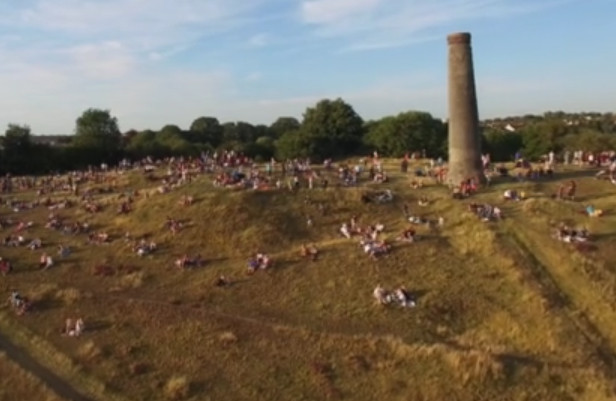 The largest recent crowds on Troopers Hill have been for watching the balloons flying from the Balloon Fiesta at Ashton Court; this photo is taken from a drone flight showing the crowds of around 600 people in 2015 - note that drone flying is now against the Parks Byelaws.
The largest recent crowds on Troopers Hill have been for watching the balloons flying from the Balloon Fiesta at Ashton Court; this photo is taken from a drone flight showing the crowds of around 600 people in 2015 - note that drone flying is now against the Parks Byelaws.
There is no doubt that prior to the opening of St George Park in around 1897 Troopers Hill was indeed one of the few publicly accessible areas of open space and was an important gathering place; some of these gatherings and demonstrations were significant enough to be recorded in the local press.
Many of these related to strikes, the Western Daily Press reported in August 1878 on a mass meeting of the operatives the Great Western Cotton Works, Barton Hill. There are also reports of mass meetings in the 1880s of Quarrymen from Fishponds & Hanham and Bootmakers from Kingswood.
By far the largest gathering we have seen reported, however, was in November 1885 to celebrate the election of Handel Cossham as the first MP for Bristol East, reported in the Western Daily Press on Saturday 28th November 1885.
"The scene at Trooper's Hill is not likely to be soon forgotten by those who were present. The spot for the demonstration was not altogether a favourable one for a wet and dark night, but a large crowd of three or four thousand persons assembled, and the utmost enthusiasm prevailed. Numerous tar barrels were placed together and ignited, and the bonfire might have been seen from the greater part of Bristol."
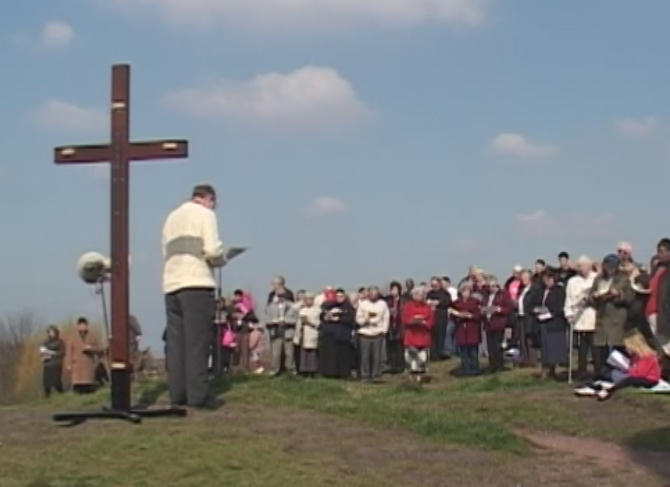 Religous meetings were also held on the Hill, this continued until very recently with the annual Good Friday Service - you can see a video of the 2005 service here.
Religous meetings were also held on the Hill, this continued until very recently with the annual Good Friday Service - you can see a video of the 2005 service here.
However, not all these religious meeting have been peaceful, the Bristol Mercury reported on Monday 8th May 1882 that
'a most disorderly scene was witnessed on Trooper's hill, St George's, yesterday afternoon.
The Kingswood detachment of the Salvation Army, headed by a brass band and by banner-bearers, after parading the neighbourhood, made their way to the hill with the intention of holding a service there; but on arriving on the breezy plateau found they had been preceded by a party of Bristol secularists, who were expounding their views.
Some of the "Salvationists" endeavoured to hustle the Freethinkers off the ground, and a regular melée ensued. In the course of the struggle turf and rotten eggs were thrown and sticks freely used. The disturbance lasted a considerable time, and ended in the rout of the secularits."
On 10th October 1928 the Western Daily Press printed a short article with two photographs taken at Troopers Hill. The article suggested that,
"the hill, if terraced, could be converted into a delightful park - a welcome addition to St Anne's Park in that part of Bristol".
The article was linked to a report of the dispute over the right of way to the cottages on Troopers Hill described on our Memories Page. In describing the Hill is said,
"It commands a magnificent view of the riverside and an industrial part of Bristol in spite of the nearness of which the hillside retains much of its natural attractiveness".

Recent History
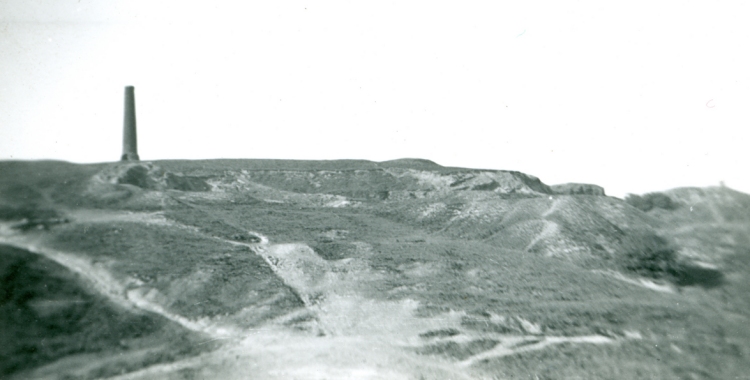 Purchase by Bristol City Council - 1956
Purchase by Bristol City Council - 1956
Mr Ballard, who purchased Troopers Hill in 1924 from the The Somers Family, died in 1936. Mr Ballard's son then sold the Hill to Frank Viner of Whites Hill Farm, Kingsway.
Bristol City Council purchased Troopers Hill from Mr Viner in 1956 for use as a public open space for £600. The adjacent land between the hill and Lamb Hill was purchased in the same year, but this was for use as Malvern Road Tip. What is now Troopers Hill Field was a farm and then allotments until the ground was leveled to form a recreation area when the adjacent tip closed.
The Hill was largely left to take care of itself and seems to have remained largely unchanged until the early 1990s, though some work was done to the chimney.
Avon Valley Regeneration - 1980s
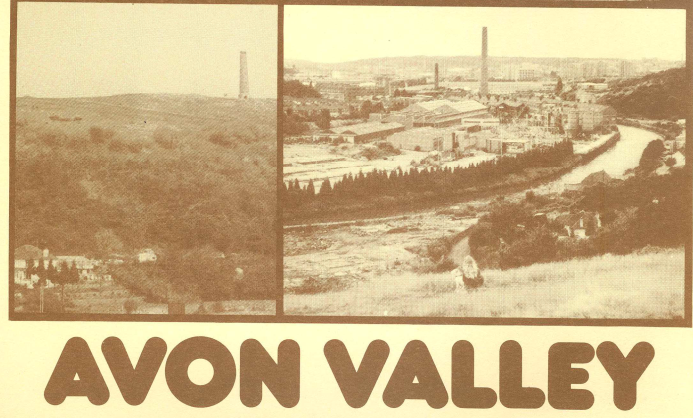 Following the closure of the Tar Works and St Annes Board Mills in the 1980s various plans were made to regenerate the Avon Valley & surrounding area - including a Bristol City Council Development Brief and Conservation Policy adopted in 1983.
Following the closure of the Tar Works and St Annes Board Mills in the 1980s various plans were made to regenerate the Avon Valley & surrounding area - including a Bristol City Council Development Brief and Conservation Policy adopted in 1983.
Troopers Hill was zoned in the plan as 'open space' and objectives included improving pedestrian access and play facilities while preserving the industrial remains and views. The wildlife corridor along the River Avon was protected, with Dundridge Park and the wooded slopes along the valley, as well as Blackswarth Road Wood to the west, also zoned as open space.
Blackswarth Road Wood is privately owned and there is no public access - it was put up for sale by auction in the summer of 2023. A crowdfunder was launched to try and buy it, but it was not sucessful.
The Development Brief was ammended in 1986 in response to a proposal to develop the land that had been occupied by the Tar Works as residential land, rather than for the industrial use indicated. One proposal for residential use of this land produced around this time was for 'Crews Hole Village'; residents' views were sought - but this plan did not progress and the Tar Works site was not developed for housing until the 1990s.
St Anne's & Crew's Hole Industrial Trail - 1980s
 As part of their plans to regenerate the Avon Valley in the 1980s, Avon County Council published a booklet describing a trail around the area highlighting various aspects of its industrial history and some of the features that could still be seen.
As part of their plans to regenerate the Avon Valley in the 1980s, Avon County Council published a booklet describing a trail around the area highlighting various aspects of its industrial history and some of the features that could still be seen.
The booklet, written by Robert Guyver, used informaton collected by St Anne's resident and historian Eddie Duffett prior to his death in 1983. There is a map showing 12 stopping points with a description of each in the text.
The booklet also includes drawings of the area by Lin Powell.
Later research has shown that some of the facts mentioned in the booklet were not correct - for example the chimney at the top of Troopers Hill was not in fact used by the Tar Works. However, it gives a good introduction to the history of the area and the route shown on the map can still be followed today.
Bristol Development Corporation Paths & Fences - 1991
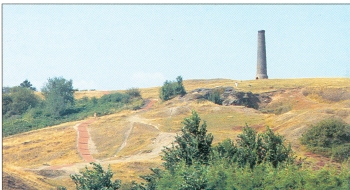 In 1989 the Bristol Development Corporation (BDC) was formed by the Government to regenerate the area.
In 1989 the Bristol Development Corporation (BDC) was formed by the Government to regenerate the area.
BDC installed fences around Troopers Hill and constructed new paths in 1991 (see Set G on our Old Photographs page). This was aimed at keeping motorcycles off the site and 'stopping Troopers Hill from wearing out'. The BDC plans and ideas for Troopers Hill and for development in Crews Hole and surrounding areas are shown in various leaflets produced by the BDC.
The first Management plan for the site looking at the Hill's habitats and wildlife was produced by the BDC in 1992. Since then there have been several updated plans. Plans and associated projects are shown on our website here: Troopers Hill Management 1992 to 2012 - Troopers Hill Management from 2012.
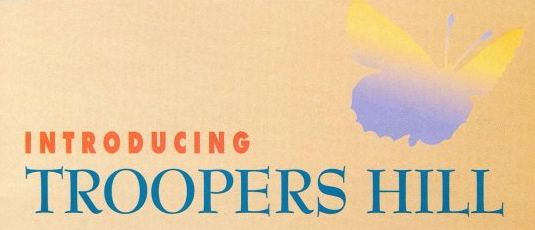 Local Nature Reserve Declaration - 1995
Local Nature Reserve Declaration - 1995
Troopers Hill was declared as a Local Nature Reserve (LNR) on 22nd June 1995 (click for copy of public notice) in recognition of the wide range of wildlife present on the hill and its importance as a unique habitat in the Bristol area due to the presence of acidic soils.
Bristol City Council produced a leaflet describing the site at around this time. Unfortunately there was also a major fire on the Hill in that year which left much of the site burnt and blackened.
 Formation of Friends of Troopers Hill - 2003
Formation of Friends of Troopers Hill - 2003
The start of the Wildspace! project in 2002 run by Sally Oldfield was the next significant event and led directly to the formation of Friends of Troopers Hill in December 2003.
Our Conservation Work Parties & Events pages have records of Friends of Troopers Hill activities since 2003.
Our events aim to promote awareness and interest in Troopers Hill Local Nature Reserve and its varied flora and fauna. We have led many guided walks, some in conjunction with wildlife surveys. We have also run 'Fun Dog Shows'; 'Music on the Hill' and 'Star Gazing'. Children's activities include an annual (weather permitting) 'Bugs & Beasties' event on the Saturday of the Balloon Fiesta..
 Friends of Troopers Hill Projects - from 2004
Friends of Troopers Hill Projects - from 2004
While our main focus has been on wildlife conservation, we have also raised funds for a series of projects to improve the Hill for visitors.
Improvements have included new paths on the Hill itself and across Troopers Hill Field and in the Woodland. We have installed new benches and interpretation boards. The wooden fencing that was installed by Bristol Development Corporation was starting to rot and has been replaced by metal estate type fencing. Two of the entrances from Troopers Hill Road have also been remodelled.
Many of these projects were to address issues raised on a survey carried out by Sally Oldfield in 2002. Friends of Troopers Hill repeated this survey 20 years later and the results can be seen here.
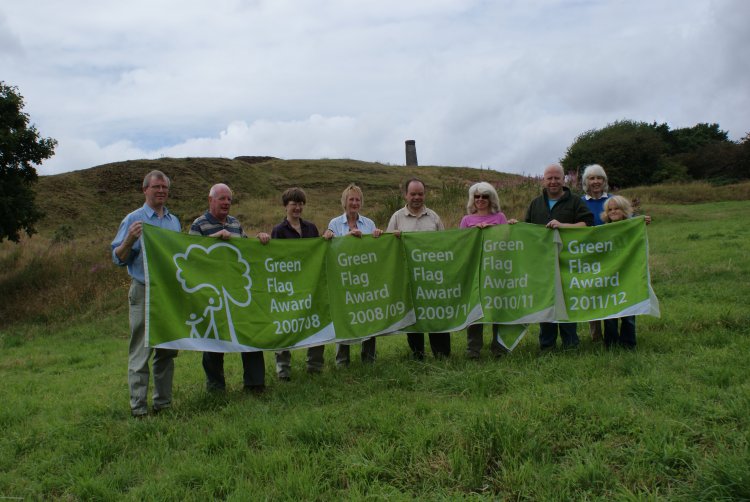 Green Flag & RHS Awards from 2007
Green Flag & RHS Awards from 2007
Green Flags are a national award scheme for quality green spaces. Troopers Hill was entered by Bristol City Council each year from 2007 to 2013 and was successful each time. A flag pole was errected at the Greendown entrance to fly the Green Flag.
Since 2014 Friends of Troopers Hill have been entering the RHS Britain in Bloom South West Parks and Open Spaces award scheme. This Scheme also requires an assessment of the management of the site by an external assessor but is more focused on community involvement. Troopers Hill has received the top award in each assessment.
 Covid Pandemic - 2020 & 2021
Covid Pandemic - 2020 & 2021
During the early stages of the Covid Pandemic all our events, activities and meetings were cancelled. However, Troopers Hill became a very popular space for daily exercise and later for meeting friends, initially one to one (at 2m distance) and later in groups of six.
During the initial stages the play area was closed, and use of the benches was also banned, but the restrictions were later relaxed. Visitor numbers were far higher than usual causing increased wear on paths and steps. The footpaths in the Woodland also got more use than they ever had before.
In the summers of 2020 and 2021 gathering at the top of the Hill to see the sunset became particularly popular.
extract1.jpg) The area that is now known as Troopers Hill is on the edge of Kingswood Forest or Chase overlooking the river Avon. As can be seen from the extract shown on the right, the hill was named as 'Harris hill' on a map of Kingswood dated 1610. A larger section can be seen here.
The area that is now known as Troopers Hill is on the edge of Kingswood Forest or Chase overlooking the river Avon. As can be seen from the extract shown on the right, the hill was named as 'Harris hill' on a map of Kingswood dated 1610. A larger section can be seen here.
 One of the partners and an active manager of the brass company from its start was
One of the partners and an active manager of the brass company from its start was 








 William Butler was born on 28th February 1819 in Leicestershire, he married Ann Boam in 1839 at Spondon in Derbyshire. It is likely that William came to Bristol in 1840 to work on railway construction in the area, including on the Bristol and Exeter Railway, almost certainly for George Hennet. In 1841 he was living in Bedminster and his occupation was given on his second child's birth certificate as 'plate-layer'.
William Butler was born on 28th February 1819 in Leicestershire, he married Ann Boam in 1839 at Spondon in Derbyshire. It is likely that William came to Bristol in 1840 to work on railway construction in the area, including on the Bristol and Exeter Railway, almost certainly for George Hennet. In 1841 he was living in Bedminster and his occupation was given on his second child's birth certificate as 'plate-layer'.



 In 1962 the Gas Board became sole owners of Bristol and West Tar Distillers, and soon afterwards Butlers moved all their other operations away from Crews Hole and Silverthorne Lane to a new base at the Rockingham Works at Avonmouth where they operated under the name of Butlers Chemicals Ltd. Butler's had had a fuel distribution depot at Royal Edward Dock in Avonmouth since the 1920s and this part of the business also continued. Below Troopers Hill the Gas Board continued to operate the tar works to treat the crude tar generated from the production of town gas, the tar still came to Crews Hole from Bristol and the wider area, including Bath, Weston-super-Mare, Bridgewater, Cheltenham & Glouscester as well as South Wales.
In 1962 the Gas Board became sole owners of Bristol and West Tar Distillers, and soon afterwards Butlers moved all their other operations away from Crews Hole and Silverthorne Lane to a new base at the Rockingham Works at Avonmouth where they operated under the name of Butlers Chemicals Ltd. Butler's had had a fuel distribution depot at Royal Edward Dock in Avonmouth since the 1920s and this part of the business also continued. Below Troopers Hill the Gas Board continued to operate the tar works to treat the crude tar generated from the production of town gas, the tar still came to Crews Hole from Bristol and the wider area, including Bath, Weston-super-Mare, Bridgewater, Cheltenham & Glouscester as well as South Wales. The introduction of North Sea Gas stopped the production of tar at the various gas works, but tar was still being produced by the coke works linked to the steel industry in South Wales and so a means of getting rid of this waste product was still required.
On 1st April 1970 the ownership of Bristol and West Tar Distillers changed hands for the last time when it became owned by the British Steel Corporation (BSC). The contraction of the steel industry in the late 1970s reduced the need for tar distillation and so the Crews Hole works closed in 1981 as BSC reduced the number of tar plants that they operated.
The introduction of North Sea Gas stopped the production of tar at the various gas works, but tar was still being produced by the coke works linked to the steel industry in South Wales and so a means of getting rid of this waste product was still required.
On 1st April 1970 the ownership of Bristol and West Tar Distillers changed hands for the last time when it became owned by the British Steel Corporation (BSC). The contraction of the steel industry in the late 1970s reduced the need for tar distillation and so the Crews Hole works closed in 1981 as BSC reduced the number of tar plants that they operated.


 A major controversy raged in St George in 1888 over the construction of a Smallpox Hospital on Troopers Hill.
A major controversy raged in St George in 1888 over the construction of a Smallpox Hospital on Troopers Hill. 

 Purchase by Bristol City Council - 1956
Purchase by Bristol City Council - 1956

 In 1989 the Bristol Development Corporation (BDC) was formed by the Government to regenerate the area.
In 1989 the Bristol Development Corporation (BDC) was formed by the Government to regenerate the area.
 Formation of Friends of Troopers Hill - 2003
Formation of Friends of Troopers Hill - 2003


